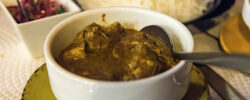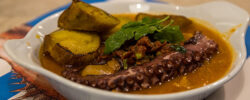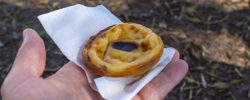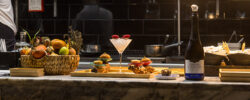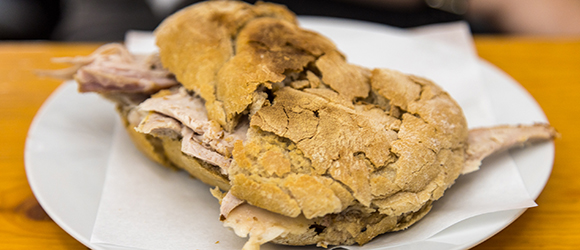
Restaurante Nova Pombalina (Lisbon, Portugal)
After a morning of checking out churches and panoramic views (and an aborted attempt at Castelo São Jorge due to unusually heavy crowds), we decided it would be good to seek out a light lunch, and this was a perfect opportunity to drop down into the Baixa and check out one of it’s venerable institutions, Restaurante Nova Pombalina.
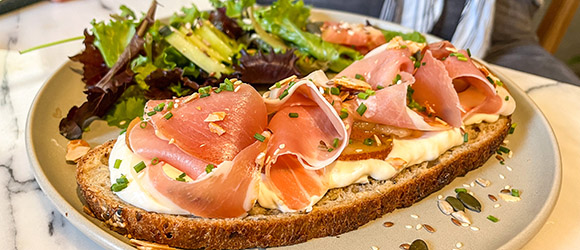
Hello, Kristof (Lisbon, Portugal)
Our third full day in Lisbon involved a trek up to visit Igreja da Graça, one of Libson’s oldest churches and convents, which sits atop one of the city’s tallest hills (and, coincidentally, has an extremely nice rooftop terrace for viewing the city). Before heading up there, we stopped for breakfast, settling on a small place we had encountered a few times before: Hello Kristof.
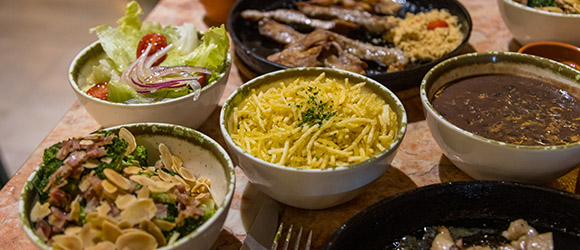
Jacaré (Lisbon, Portugal)
Our third day in Lisbon was mostly spent visiting the Gulbenkian Museum, which has both classical and modern art wings, and one of the better collections of Rembrandt, Monet, Rubens, Manet, Renoir, and Degas. Between doing the classical wing and the modern art wing, we decided to break for lunch, and head to the nearby El Corte Ingles (a chain of Spanish department stores) to check out their food court on the top floor. It’s an impressive food court, with a selection of Portuguese, Spanish, Japanese, and Brazilian restaurants around a central seating court. After reviewing several of the menus, we settled on the Brazilian place, Jacaré.
Tentações de Goa (Lisbon, Portugal)
While much of our dining in Portugal focused on Portuguese cuisine, there was one particular ethnic cuisine I was looking to experience, and knew we could find several examples of in Lisbon: Goan Cuisine. Goa, an Indian State in the Konkan region, was Portuguese ruled from 1510 to 1961, and the cuisine of Goa diverged a bit from the surrounding Konkan region over this period, mostly by adapting Portuguese customs (particularly, the use of pork and beef), customs (using vinegar), and ingredients (pineapple, cashews, guavas, tomatoes, and potatoes were all introduced by the Portuguese to Goa). The resulting Goan cuisine remains distinct, and there are quite a few restaurants around Lisbon either labeling themselves Goan, or labeling themselves “Indian” but with heavy Goan influence. One of the better-rated ones, on the edge of the Moorish quarter, is Tentações de Goa (“Temptations of Goa”), and we decided to check them out for our second dinner in Lisbon.
Sea Me (Lisbon, Portugal)
After we returned to central Lisbon from Belém, we were looking for a light lunch, and that was a particularly good opportunity to visit Time Out Market Lisboa. Set up within half of Lisbon’s Mercado da Ribeira on Lisbon’s waterfront, Time Out Market is one of these modern “Food Hall” (upscale food courts) with a collection of independent restaurants all running food service stalls, with central seating and table bussing. This was the hot new trend in dining in the years leading up to the Pandemic (I particularly have experienced a few like Eataly and Galley Group), but Time Out Market was one of the earlier ones, and still thriving. In fact, almost a little too thriving: at most lunchtimes, the place is packed with little seating. But there’s a small secret to Time Out Market Lisboa: along the western side of the market is a secondary hallway that features the same restaurants as that side of the Market, but with counter seating. It’s a bit less busy, and that’s where we found our lunch, at Sea Me.
Pastéis de Belém (Belém, Portugal)
My last post covered one of the best-rated places to get Portugal’s most famous dessert/snack treat, Pastéis de Nata, at Manteigaria in central Lisbon. However, no discussion of Pastéis de Nata is complete without a discussion of another, similar famous Pastéis, the Pastéis de Belém. Unlike the ubiquitous Pastéis de Nata, Pastéis de Belém are basically available from one place, the eponymous Pastéis de Belém bakery in Lisbon’s Belém waterside district.
Manteigaria (Lisbon, Portugal)
After we finished exploring Coimbra for 3 days, it was time to head back to Lisbon for the last several days of our vacation. After a relatively quick and pleasant train ride on the Alfa Pendular train, we arrived at Lisbon’s Santa Apolónia railway station (Lisbon’s oldest), checking into the quite posh Editory Riverside, which is actually built from the old in-station hotel. Checking in, the friendly clerk at the front desk offered up quite a few recommendations for dining in Lisbon, and particularly, a recommendation for breakfast: going into the Baixa district and having a proper Pastel de Nata at Manteigaria.
Seoul Chicken (Coimbra, Portugal)
As we were wandering about Coimbra, our paths frequently took us through Praça do Comércio, which has several restaurants, bars, and gelato shops amongst the various furniture shops and churches that complete one of Baixa Coimbra’s main shopping areas. But there was once place that was impossible to ignore, since almost every daytime trip through the Praça smelled strongly of KFC. No, not Kentucky Fried Chicken, but it’s Eastern sibling, Korean Fried Chicken. Each trip through the Praça smelled richly of heavily spiced fried chicken, garlic, kimchi and gochujang. And while was was adoring Portuguese food, it isn’t exactly known for being particularly spicy, so after a half dozen passes through the area, we finally gave into the temptation and stopped in to Seoul Chicken for lunch.
A Tasquinha (Coimbra, Portugal)
After our near-legendary marathon dining session at O Palco the previous evening, on our second day in Coimbra we were looking for a rather light lunch the next day as we were wandering the many steep streets of Coimbra. This eventually brought us to a place I had seen the previous day while walking R. Quebra Costas (“The Street that Breaks Ribs”), a steep staircase just below Sé Velha de Coimbra. Halfway up the steps is this little joint, A Tasquinha (“The Tavern”) with a single service counter with some stools, and a few small tables spilling out onto the outdoor stairs in good weather. This was pretty much exactly the sort of light lunch spot we were looking for.
O Palco (Coimbra, Portugal)
After we finished with our coastal hike, we eventually needed to get back to Lisbon for our return trips. Instead of heading back through Porto (which all of us had previously experienced), we decided that we’d take a minor diversion to check out another of Portugal’s major cities: Coimbra. Home to Portugal’s primary university, Coimbra is an old town on a hillside that, in a country known for steep cities, is particularly steep, and fun to explore. Another advantage of Portugal is that it has quite a few high-end (and particularly Michelin-starred) restaurants that are still relatively affordable, and a few of the better-reviewed places in Portugal are located in Coimbra. We ended up taking our first evening in Coimbra to visit O Palco (“the stage”). While they haven’t yet received a star, they have some top-of-class cuisine, with an elaborate 12-course meal.

